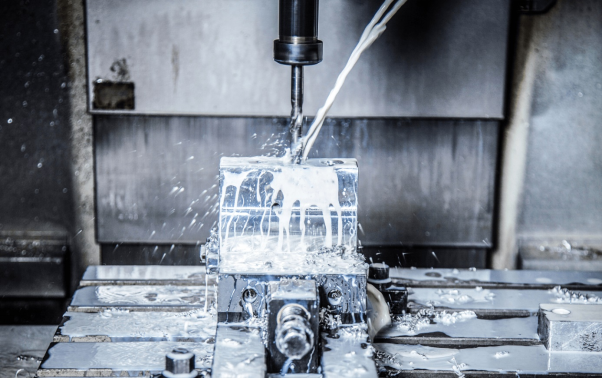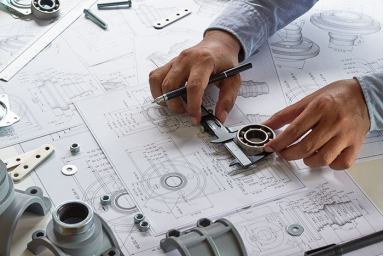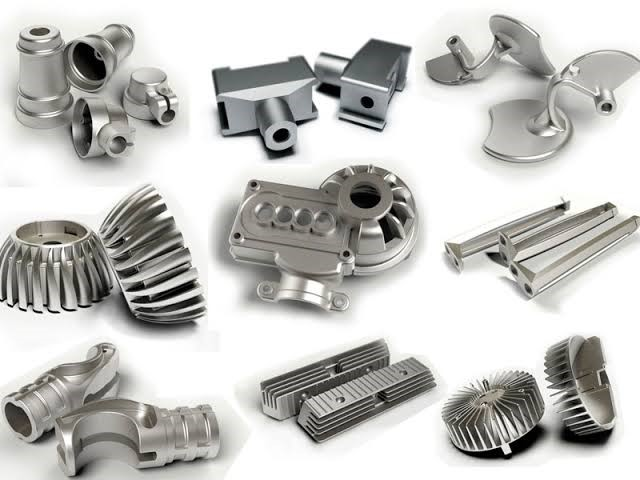Design For Manufacturing: A Practical CNC DFM Guide
 Jul 17,2025
Jul 17,2025

Success in any department, operation or application is based on planning or strategy. If you get into a task with no plans, the chances of failure will increase. So, the strategy is the main thing in any action, including CNC machining. In engineering, a term is used, “Design for Manufacturing (DFM)” which is basically a strategy we make during designing and before CNC machining. The survey shows that if you get into CNC machining after proper DFM strategies, the production time will be reduced by 30% and material waste will be reduced by 20%, which means greater efficiency in production. The accuracy and precision in CNC machining lead towards products according to the exact required data. This article covers comprehensive information related to design for manufacturing strategies. So, let's start with it introduction:

What Is Design for Manufacturing (DFM)?
Design for Manufacturing is a structured approach to designing products while keeping the factors which can affect manufacturing in mind. It's a bridge between innovative engineering and real-world applications. DFM enables you to create high-quality, affordable and simple-to-machine products through CNC machining. DFM refines the designs before CNC machining to reduce the chances of errors while manufacturing.

- What Does DFM Stand for in Manufacturing?
Let's understand what DFM does in manufacturing and why it is so important. So, basically, DFM simplifies designs, chooses the right materials, and reduces unnecessary machining steps, which ultimately results in boosted efficiency and reduced costs. For instance, if you do not make deep pockets in the Al parts, it will save your time, extend the tool's life and reduce machining cost, but will keep quality.
In simple words, DFM ensures your designs are both functional and cost-effective right from the start.
- What Counts as DFM?
A DFM can be good and can be poor, depending on its efficiency, for instance:
- Good DFM:
- To prevent stress concentrations and simplify machining, the corners will be rounded by a minimum 0.5 mm radius.
- For consistent material flow and reduced warping, the wall thickness will be uniform, i.e. within ±10%.
- To minimise tool changes and lower production costs, the hole sizes will be standard.
- Poor DFM
A DFM can be poor if it has the following issues in the design:
- Overly complex geometries.
- Unnecessary tight tolerances.
- Mixed materials in one part (e.g., metal-plastic hybrids).
- What does Machining Mean in Manufacturing?
Machining means simply if you shape a raw material into a product through proper, accurate tools. For instance, if you use a CNC machine and other advanced tools to make a turbine blade of Ni-alloy, that process from raw material to product is called machining in manufacturing.
DFM vs. DFA vs. DFMA
The following table provides insights into general differences between DFM, DFA and DFMA:
|
Methodology |
Focus Area |
Key Principle |
Benefits |
Example Application |
|
DFM (Design for Manufacturing) |
Individual part production |
Simplifying geometries for easier machining |
Reduces machining time by 20-30% |
Optimising gear tooth profile for CNC milling |
|
DFA (Design for Assembly) |
Part joining processes |
Minimising fasteners and assembly steps |
Cuts assembly time by 40% |
Replacing screws with snap-fits in plastic housings |
|
DFMA (Design for Manufacturing & Assembly) |
Integrated production system |
Combining DFM and DFA principles |
Lowers total production costs by 25-35% |
Designing car dashboards as modular components |
How DFM Impacts Cost, Quality, and Lead Time
A DFM is very important in the world of manufacturing. For instance, a good DFM results in savings, good quality and low lead time. And at the same time, if it is a poor DFM, it can be a potential source of material, time, energy and money waste.
- Cost: A good DFM can save money 15% while maintaining functionality by optimising tolerances.
- Quality: A good DFM will avoid thin walls (<1mm) to prevent part deformation during machining and improve structural integrity.
- Lead Time: Simplified designs with standardised features in a good DFM will save production time by 18% and reduce setup changes.
5 Principles of Effective DFM for CNC Precision Machining
In this section, you will read the 5 most important principles for effective CNC precision machining:
1. Process–Material Fit
Choosing the right materials that fit your project is the most basic criterion in DFM in the CNC process. For instance:
- If you choose soft Aluminium (6061): Ideal for fast machining (up to 10,000 RPM).
- In case of Hardened Steel (4140): Requires slower speeds (1,500 RPM) but offers durability.
2. Part Geometry Simplification
Make your designs simple, such as:
- Before DFM: Complex undercuts and uneven walls.
- After DFM: Unified thickness (≥1mm) and open corners.
3. Tolerance Optimisation
The following table provides information on how tighter tolerances affect cost and production during the manufacturing phase:
|
Tolerance (±) |
Cost Impact & Production Considerations |
Use Case Examples & Technical Requirements |
|
0.1 mm |
Standard machining rate - No special tooling required - Ideal for high-volume production |
Consumer electronics housings - Protective enclosures with non-critical fits |
|
0.05 mm |
25% cost premium - Requires precision tooling - Additional quality checks |
Automotive transmission gears - Hydraulic components |
|
0.01 mm |
50-75% cost increase - Specialised equipment needed - Temperature-controlled environment |
Aircraft turbine blades - Optical alignment components |
4. Assembly & Joining Strategy
Design parts for easy assembly:
For faster assembly, use Dowel pins to self-align parts while reducing human error during manual positioning.
Eliminate screws and use snap-fit bosses in plastic enclosures to speed up production and lower part count.
5. Environment and Compliance
It is important to remain compliant with Operational and regulatory needs:
- ROHS/REACH Compliance:
Verify material certifications with your supplier to meet EU environmental regulations. For instance, avoid banned substances like cadmium and lead.
- Corrosion Resistance
In humid environments, specify anodising (Type II or III) for aluminium parts. This creates a protective oxide layer that prevents oxidation and wear.

DFM Workflow: From Concept to Production-Ready CAD
To efficiently transmit your concept to production, you can follow the following proven steps. Because a successful strategy can save up to 15-20% costs. So, let's start learning these steps:
Step 1- Collaborate Early
A machinist is the best instructor during DFM because he knows exactly how manufacturing is done practically. He will have the exact idea, what possible errors can happen, etc.
Step 2- Simplify CAD
Keep your designs simple and remove unnecessary features like tiny fillets or micro-text because these are more time-consuming.
Step 3- Run Digital Checks
It is wise to run digital checks before getting into real machining, such as using CAM to detect tool collisions.
Step 4-Prototype Fast
Make a prototype, then test it during CNC machining and finally start the real-life application machining.
How DFM Cuts Cost in CNC Machining Processing?
In this section, you are going to learn how practically a good DFM cuts costs in CNC machining.
Setup and Tooling Choices
You should have an idea about the selection of a setup and tool while designing a DFM. Use 3-axis machines for simple parts and 5-axis machines for complex shapes.
Cutting Time & Toolpath Efficiency
For fast material removal, use high-efficiency toolpaths such as trochoidal milling because these tools are 30% faster than traditional tools.
Scrap Reduction
You can reduce material waste up to 15-20%. A good DFM minimises off-cuts through optimised part design and intelligent batch planning.
What Are CNC Feature Design Rules for Machinable Parts?
You can reduce costs by following these CNC design rules without compromising part performance or functionality.
Wall Thickness, Ribs, and Aspect Ratios
The purpose of the following table is to make you familiar with how much you need the minimum wall thickness to reduce the number of defects.
|
Material |
Minimum Wall Thickness |
Key Consideration |
|
Aluminium |
1.0mm |
Uniform thickness prevents warping |
|
Steel |
1.5mm |
Ensures structural integrity |
|
Plastic |
1.2mm |
Critical for machining stability |
Pockets, Slots, and Undercuts
- To reduce stress concentrations, avoid sharp internal corners (use radii ≥1mm).
- For standard tool access and easier machining, design undercuts >6mm wide.
- Limit pocket depth to 4x width for tool stability.
Threads, Holes, and Bosses
Use standardized tools, sizes and materials for saving time, material and money.
|
Thread |
Drill Size |
Tap Size |
|
M4 |
3.3mm |
ISO |
|
1/4-20 |
5.1mm |
UNC |
Surface Finish and Post-Processing Prep
Surface finish is the final step in CNC machining. Sometimes, post-processing is required for enhanced surface quality.
|
Finishing Process |
Surface Roughness (Ra) |
Typical Application |
|
Anodizing |
0.8 - 1.6 μm |
Decorative or protective coatings |
|
Powder Coating |
1.6 - 3.2 μm |
Durable surface finishes |
|
As-Machined |
3.2 - 6.3 μm |
Non-critical functional surfaces |
Designing for Robust Workholding
- Include flat clamping surfaces on multiple sides
- To prevent vibration during cutting, avoid delicate protrusions near edges
- For stable fixturing, add 3mm sacrificial tabs
When to Combine CNC and Additive Manufacturing? - Hybrid Production Advantages
- Some factors that are difficult to machine, such as complex internal channels
- The parts requiring unique geometries, customised for low-volume
You can reduce manufacturing costs by 25-40% through hybrid production while expanding design possibilities for these cases.
Material Selection Strategies for DFM
Material selection is the most basic criterion in strategies for DFM. Different industries rely on different materials such as aerospace priorities aluminium, automotive relies on steel, and medical mandates titanium. You should compare raw material expenses against machining time and tool wear.
Metals—Aluminium, Steel, Titanium
|
Material |
Cost/cm³ |
Spindle Speed |
Machinability |
Common Types |
|
Aluminum |
$0.50 |
10,000 RPM |
Excellent |
6061, 7075 |
|
Steel |
$0.80 |
1,500 RPM |
Moderate |
4140, 304SS |
|
Titanium |
$3.20 |
800 RPM |
Difficult |
Grade 2, Grade 5 |
1.Aluminum and Aluminum Alloys
- 6061offers easy machining, good strength.
- 7075 is stronger and used for lightweight parts across aerospace and consumer electronics. It is harder to machine.
2.Steel Types
- For balanced machinability and strength, use 4140 (HRC 28-32).
- 304stainless steel is ideal for automotive and industrial components. It resists corrosion, but wears tools faster.
3.CNC Titanium Grades
Titanium is an essential material for medical implants and high-performance aerospace applications. Grade 2 and Grade 5 are the most common. Both require slow speeds and rigid setups.
Plastics—Delrin, PEEK, POM
|
Material |
Machining Requirements |
Challenges |
Applications |
|
Delrin |
Metal-like; low heat sensitivity |
Minimal |
Medical, electrical |
|
PEEK |
Sharp tools, active cooling |
Distortion, shrinkage |
Medical, aerospace |
Soft Metals vs. Hardened Alloys
Select based on your component's service life requirements.
|
Material Type |
Machining Characteristics |
Tooling Requirement |
Key Consideration |
|
Soft Metals (BHN <150) |
Easy machining, high wear rate |
Standard tools |
Short-term applications |
|
Hardened Alloys (HRC >45) |
Difficult machining, high longevity |
Coated tools |
Long-term performance |
Design for Manufacturing in Various Industries
Every industry has its own kind of DFM because of different materials, their applications, etc. Especially for those new teams and startups. In this section, DFMs for different industries are briefly discussed:
DFM in Medical Devices
Implants and surgical tools demand absolute precision with zero defects.
Medical DFM prioritises:
- Biocompatible materials (Ti6Al4V, PEEK)
- Ra <0.4μm surface finishes for sterilisation
- Complex geometries via 5-axis CNC
- Strict documentation for FDA compliance
DFM in Automotive Powertrain Parts
Powertrain components must be durable under extreme conditions.
Automotive DFM focuses on:
- High-volume production of steel/aluminium components
- Tight tolerances (±0.05mm) for engine blocks
- Standardised fasteners for assembly efficiency
- Cost reduction through multi-cavity moulds
DFM in Robotics & Automation Components
These custom designs balance strength with repetitive motion reliability
Robotics DFM requires:
- Lightweight aluminium frames with stiffening ribs
- Precision bearing seats (±0.01mm)
- Cable routing channels in structural parts
- Snap-fits for quick maintenance
TUOFA CNC Machining - Design for Your Manufacturing Success
Toufa is a China-based company which has expert CNC operators and totally advanced CNC machines. We make sure that the customer's requirements are fully met through our skills, expertise and advanced machines. We will help you from concept to real-life production using a good DFM.
- Precision Machining
Up to ±0.01mm tolerances with 5-axis CNC for critical components are easily accessible in Toufa.
- Material Options
In Tuofa, 50+ metals/plastics, including aluminium, steel, titanium, and PEEK, can be easily machined on CNC machines.
- Industry Specialization
Tuofa is an expert industry of manufacturing in medical, automotive, aerospace, and electronics.
- Full-Scale Production
From prototyping to high-volume runs with integrated quality control, Toufa will provide.
- Cost Optimization
Through smart DFM, 30% waste reduction and 25% faster machining.
- Quality Certified
ISO 9001 compliant with full material traceability and inspection.
- Sustainable Manufacturing
Tuofa has Eco-friendly processes with recycling and energy-efficient operations.
Conclusion
DFM optimises CNC projects by cutting costs while improving quality. A good DFM helps create parts that machines can quickly make, waste less material, and perform reliably. Whenever you want advancements, come to Tuofa. Our DFM experts will refine your designs.
FAQ
How tight can tolerances be without raising costs?
up to ±0.05 mm tolerance does not increase machining costs.
Does 5-axis CNC need different DFM rules?
Yes, for 5-axis CNC machines, DFM reduce costs by avoiding deep cavities and incorporating tool access angles to utilise 5-axis capabilities and minimise secondary operations fully.
How does DFM support sustainability?
a good DFM supports sustainability by:
- reduces material waste by 15-25%
- minimises energy-intensive machining steps
- enables efficient material utilisation
 Tel/WeChat:
Tel/WeChat:  Email:
Email: 
 Home
Home
 Knurling: A Complete Guide for Process, Types & Patterns
Knurling: A Complete Guide for Process, Types & Patterns 







